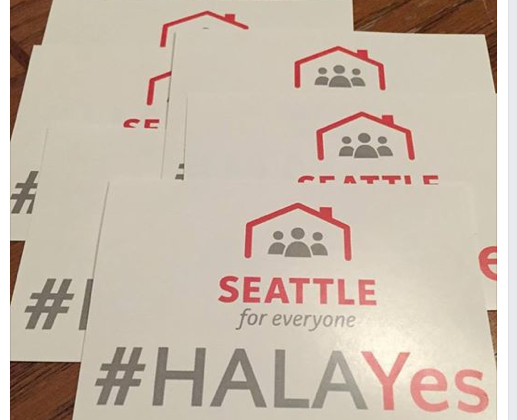Cheerleading Won’t Help Confusion About HALA and Grand Bargain
Yes, confusion. And being confused about the Mayor’s Housing Affordability and Livability Agenda (HALA) Committee’s recommendations is not the sign of being poorly informed or not that bright. It is confusing, especially if you’re not doing this work all day. Over the weekend I pointed out on the City Builders page on Facebook that even neighborhood and anti-growth advocates are confounding the recommendations of the HALA Committee (there are 65) and the Grand Bargain, the scheme that would force developers and builders to include rent restricted housing in their developments. Here’s what the Seattle Neighborhood Coalition (an anti-growth leaning group) said about the HALA recommendations and the Grand Bargain:
Elements of HALA are already in front of City Council. Backyard cottages and mother-in-law units (Accessory Dwelling Units – ADUs) are getting a public airing and will likely see a loosening of requirements, including parking and owner-occupancy, in order to boost what is currently a very marginal production. The cornerstone of the HALA recommendation however is the mandatory production of affordable units (or payment of fees)
I was rebuked by a commenter on the page,
Roger. Most people on City Builders aren’t “confused.” They just don’t agree with your POV that Grand Bargain isn’t the cornerstone of HALA. That’s your personal opinion, and believe it or not, lecturing everyone who disagrees with you about how confused they are won’t make them come around to your way of thinking. They just disagree.
So I looked up the word, “cornerstone” in the dictionary.
An important quality or feature on which a particular thing depends or is based:a national minimum wage remained the cornerstone of policy
Hmmm. So this recommendation from the 50 page plus document “depends” on the Grand Bargain?
4. More Resources: Call on the State and City to Create Additional Resources for Affordable Housing
• Strategy R.2 – Create a stable source of funding by enacting a Real Estate Excise Tax (REET) dedicated to affordable housing
• Strategy R.6– Expand the size of the critically important State Housing Trust Fund • Strategy L.1 – Prioritize use of surplus and underutilized public property for affordable housing and promote co-development in conjunction with public buildings • Strategy R.7 – Dedicate property taxes derived from new construction to affordable housing by reinstating the City Growth Fund
I don’t think so. And as I pointed out in a earlier post, the HALA recommendations are, mostly, a disparate collection of ideas and proposals. And even if they were all put into effect today, it’s hard to say what impact they would all have on housing prices or on the housing economy as a whole. The Grand Bargain is just one of those proposals. That the NIMBY set is also saying that the Grand Bargain is essential for the all these ideas to happen is an indication, yes, of confusion about how all this might work.
That is no surprise when boosters of upzones without inclusion for big downtown developers like Vulcan keep cheerleading the HALA recommendations as if it was one piece of legislation or a single, monolithic proposal that the Seattle City Council could act with a single vote. As I’ve pointed out, the cheerleaders, even some who are in the press and media, are putting HALA and the Bargain together. What does saying “HALA Yes!” really mean? Does it mane supporting the Grand Bargain even though it’s probably infeasible and maybe even illegal or does it mean supporting
Provide assistance to homebuyers between 80-120% AMI. With the current median home value in Seattle at $468,900, many middle-income homeowners are also becoming locked out of the homeownership market. However, there are limited resources to help these middle-income homebuyers. The state constitution prohibits public funding to households above 80% AMI, so these homebuyers cannot access direct assistance such as the City’s down payment assistance program. This strategy is not about changing the state constitution, but instead about exploring other ways to provide assistance that work within the current constitutional limits.
Hard to fit that paragraph from Appendix F-16 of the HALA document on a handy sticker, isn’t it?
We need to stop cheerleading the HALA document as if it was a uniform and fully vetted proposal. It simply isn’t. We’re not helping solve the problem of real people by trying to shove every single hope and every single fear in to a document that can’t possibly define and solve our housing issues. We have to do that together, and that starts with asking questions, not slapping stickers on everyone.


